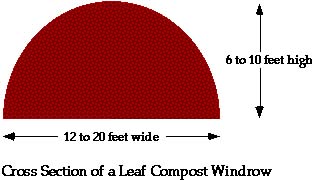

The first stages of composting are in many ways the most important, and proper windrow construction is the key to getting the process off to a good start. The two aspects of windrow building are: 1) mixing materials, and 2) forming and shaping the windrow. Both of these aspects are discussed below.
If several different types of waste are going to be composted together they must first be thoroughly blended. Mixing is required to balance the carbon and nitrogen ratio and distribute moisture throughout the pile, and also to insure an even distribution of large pores so that oxygen can move freely (see Compost Ingredients, Moisture, and Oxygen fact sheets). If grass clippings or other high nitrogen materials are being composted, this blending process is particularly critical. Mixing can be accomplished with a front-end loader, although other equipment such as tub grinders or specialized windrow turning machines are commonly used when mixing grass clippings, which tend to mat together.
The size and shape of the windrow are designed to allow oxygen to flow throughout the pile while maintaining temperatures in the proper range. If windrows are too large, oxygen cannot penetrate to the center, while if they are too small they will not heat up properly. The optimum size varies both with the type of material and with the time of year. Windrows of autumn leaves should typically be about 8 feet tall and 16 feet wide at the base, but may be built as high as 10 feet in mid winter. A windrow of grass clippings mixed with leaves will need to be considerably smaller, usually about 5 feet high and 10 feet wide. These sizes are approximate, and may need to be adjusted somewhat.

While constructing the windrows, try to avoid driving on and compacting the yard waste. The windrows can be built by lifting the material with the bucket of a front-end loader, and letting it cascade down to form a loose pile. The sides of the windrow can be as steep as the material will naturally pile up, which typically leads to a windrow about twice as wide as it is high. Windrows can be as long as is convenient for the site, up to several hundred feet in length.
|
|
|---|
|
Composting |
Engineering |
in Schools |
|
For specific comments related to this page, please contact the Cornell
Waste Management Institute (format and style), or Tom
Richard (technical content).
This page was created on August 30, 1995
This page was last updated October 2000